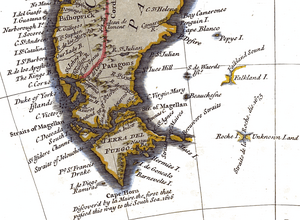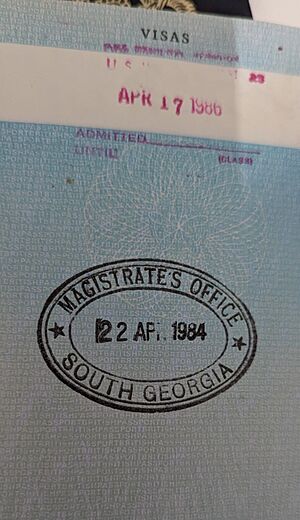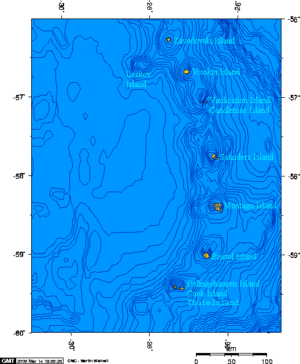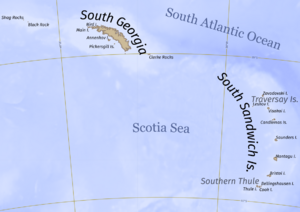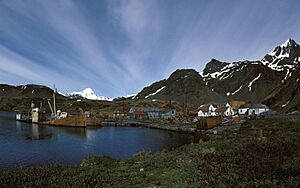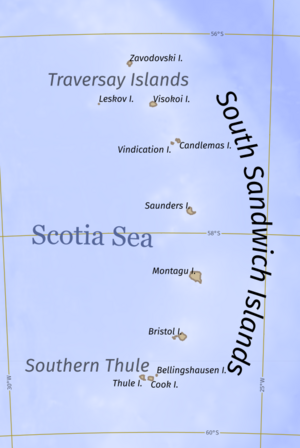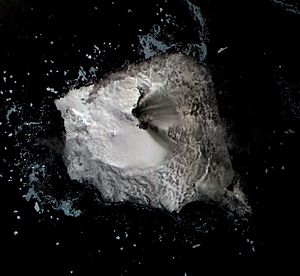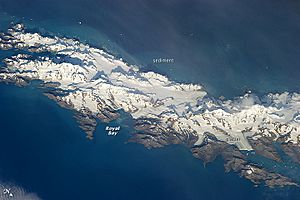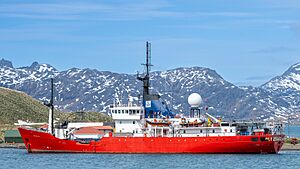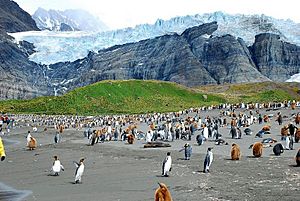South Georgia and the South Sandwich Islands facts for kids
Quick facts for kids
South Georgia and the South Sandwich Islands
|
|||
|---|---|---|---|
|
|||
| Motto(s): | |||
| Anthem: "God Save the King" | |||

Location of South Georgia and the South Sandwich Islands in the southern Atlantic Ocean
|
|||
| Sovereign state | |||
| Separation from Falkland Islands | 3 October 1985 | ||
| Capital and largest settlement
|
King Edward Point 54°17′00″S 36°30′00″W / 54.28333°S 36.50000°W |
||
| Official languages | English | ||
| Demonym(s) |
|
||
| Government | Directly administered dependency under a constitutional monarchy | ||
|
• Monarch
|
Charles III | ||
| Alison Blake | |||
| Area | |||
|
• Total
|
3,903 km2 (1,507 sq mi) (not ranked) | ||
| Currency | Pound sterling Falkland Islands pound (£) (FKP) |
||
| Time zone | UTC−02:00 | ||
| Date format | dd/mm/yyyy | ||
| Driving side | left | ||
| Calling code | +500 | ||
| UK postcode |
SIQQ 1xx
|
||
| ISO 3166 code | GS | ||
| Internet TLD | .gs | ||
South Georgia and the South Sandwich Islands (SGSSI) is a British Overseas Territory located in the southern Atlantic Ocean. It is a group of remote and rugged islands. The territory includes South Georgia and a chain of smaller islands called the South Sandwich Islands. South Georgia is the largest island, measuring about 165 kilometers (103 miles) long and 35 kilometers (22 miles) wide. The South Sandwich Islands are located about 700 kilometers (435 miles) southeast of South Georgia. The total land area of the territory is 3,903 square kilometers (1,507 square miles). The Falkland Islands are about 1,300 kilometers (808 miles) to the west.
The South Sandwich Islands have no people living on them. South Georgia has a very small population that does not stay there permanently. There are no regular flights or ferries to the islands. However, many cruise ships visit South Georgia, bringing thousands of tourists each summer.
The United Kingdom claimed South Georgia in 1775 and the South Sandwich Islands in 1908. The territory of "South Georgia and the South Sandwich Islands" was officially created in 1985. Before that, it was part of the Falkland Islands Dependencies. Argentina also claimed South Georgia in 1927 and the South Sandwich Islands in 1938.
Argentina had a naval station, Corbeta Uruguay, on Thule Island in the South Sandwich Islands from 1976 until 1982. The Royal Navy closed it down. Argentina's claim over South Georgia was one reason for the 1982 Falklands War. During this war, Argentine forces briefly took over the island. Argentina still claims these islands as part of its Tierra del Fuego, Antártida e Islas del Atlántico Sur Province.
Toothfish are very important to the islands' economy. Because of this, Toothfish Day is celebrated on September 4th as a public holiday in the territory.
Contents
- Exploring the History of South Georgia and the South Sandwich Islands
- Languages Spoken on the Islands
- Geography: Exploring the Islands' Landscape
- Climate: Weather in the South Atlantic
- Government: How the Islands are Ruled
- Economy: How the Islands Make Money
- Ecology: Plants and Animals of the Islands
- Military Presence
- See also
Exploring the History of South Georgia and the South Sandwich Islands
South Georgia's Past
Early Discoveries (17th to 19th Centuries)
The island of South Georgia was first seen and visited in April 1675 by Anthony de la Roché. He was a London merchant and an Englishman. He spent two weeks in one of the island's bays. The island was shown as Roche Island on early maps. Another ship, the Spanish León, saw it in June 1756.
James Cook sailed around the island in 1775 and was the first to land there. He claimed the land for the Kingdom of Great Britain. He named it the "Isle of Georgia" to honor King George III of the United Kingdom. British rules for governing South Georgia were set up in 1843.
In 1882–1883, a German expedition set up its base at Royal Bay. This was for the first International Polar Year. Scientists there studied the transit of Venus. They also recorded waves from the 1883 eruption of Krakatoa. Seal hunting started in South Georgia in 1786 and continued through the 1800s. The waters were dangerous, and many ships were wrecked there.
Whaling and Modern Times (20th and 21st Centuries)
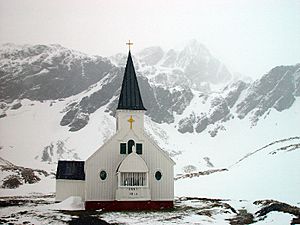
South Georgia became a major base for whaling in the 1900s. A Norwegian named Carl Anton Larsen built the first land-based whaling station. This first permanent settlement was at Grytviken in 1904. His Argentine Fishing Company ran it until 1965. Whaling stations operated under special permits from the Governor of the Falkland Islands. There were seven stations, all on the north coast, which had safe harbors:
- Prince Olav Harbour
- Leith Harbour
- Stromness
- Husvik
- Grytviken
- Godthul
- Ocean Harbour
Working at the whaling stations was difficult and dangerous. After the whaling industry ended, the stations were left empty. Today, only a few buildings remain, like the South Georgia Museum and the Norwegian Lutheran Church at Grytviken. The rest are just decaying ruins. From 1905, the Argentine Meteorological Office helped run a weather station at Grytviken.
In 1908, the United Kingdom made new rules for its South Atlantic lands. These included South Georgia, the South Orkneys, the South Shetlands, the South Sandwich Islands, and Graham Land. In 1909, an administrative center was set up at King Edward Point on South Georgia. This was near the Grytviken whaling station. A British administration and magistrate managed the territory. They enforced British law and regulated all activities. This area was then known as the Falkland Islands Dependencies. Around 1912, the largest whale ever caught, a blue whale 110 feet (34 meters) long, was brought to Grytviken.
In April 1916, Ernest Shackleton's Imperial Trans-Antarctic Expedition got stuck on Elephant Island. This island was about 800 miles (1,287 km) southwest of South Georgia. Shackleton and five friends sailed in a small boat to get help. On May 10, after an amazing journey, they landed at King Haakon Bay on South Georgia's south coast. Three stayed at the coast, while Shackleton, Tom Crean, and Frank Worsley hiked 22 miles (35 km) across the island's mountains. They reached the Stromness whaling station for help. The other 22 expedition members on Elephant Island were later rescued. In January 1922, Shackleton died on a later trip while his ship was in King Edward Cove, South Georgia. He is buried at Grytviken. The ashes of another explorer, Frank Wild, were buried next to Shackleton in 2011.
Argentina claimed South Georgia in 1927. During World War II, the Royal Navy sent a ship to patrol South Georgian waters. They also set up two shore guns to protect Cumberland Bay and Stromness Bay. These were operated by Norwegian whalers. The base at King Edward Point became a research facility in 1949–1950. It was run by the British Antarctic Survey.
The Falklands War began on March 19, 1982. A group of Argentinians, pretending to be scrap-metal dealers, took over the old whaling station at Leith Harbour on South Georgia. On April 3, Argentine troops attacked and occupied Grytviken. British forces recaptured the island on April 25, in Operation Paraquet.
In 1985, South Georgia and the South Sandwich Islands became a separate territory. The King Edward Point base, which was a military base after the Falklands War, returned to civilian use in 2001. It is now operated by the British Antarctic Survey.
South Sandwich Islands' Story
Captain James Cook found the southern eight islands of the Sandwich Islands Group in 1775. He thought the southernmost three were one island. Their true status as separate islands was confirmed in 1820 by Fabian Gottlieb von Bellingshausen. Bellingshausen discovered the northern three islands in 1819. Cook first named them "Sandwich Land" to honor John Montagu, 4th Earl of Sandwich. The word "South" was added later to avoid confusion with the "Sandwich Islands," which are now known as the Hawaiian Islands.
Southern Thule, at the south end of the island chain, is the southernmost land on Earth not covered by the Antarctic Treaty.
Argentina claimed the South Sandwich Islands in 1938. They challenged British control over the islands many times. From 1955 to 1956, Argentina had a summer station called "Teniente Esquivel" on Thule Island. Argentina also had a naval base (Corbeta Uruguay) from 1976 to 1982 on the same island. The British found out about this base in 1976 and protested. They tried to solve the issue through talks. The base was removed on June 20, 1982, after the Falklands War.
Languages Spoken on the Islands
The only official language of the territory is English. It is widely used by residents and for almost all government tasks. Even though English is used for most government work, the islands' motto Leo Terram Propriam Protegat is in Latin. It means "May the Lion protect his own land." New place names were decided by rules from 1956 and 1957. On September 11, 2020, new rules were made for naming places.
When British captain James Cook explored the islands, he set a standard for naming new places. Names were chosen to honor expedition sponsors, officers, and crew. They also reflected important events or described the physical features of the place. Later explorers, including Russian explorer Fabian Gottlieb von Bellingshausen, mostly followed this standard. Bellingshausen named six places during his 1819-1821 Antarctic expedition.
Places named by Cook include Clerke Rocks, Possession Bay, and Bay of Isles. Other English names were given later to remember American whalers. These include Morrell Point, Wasp Point, Pacific Point, and Comer Crag. Important Russian names chosen by Bellingshausen include the Traversay Islands, Zavodovski Island, and Visokoi Island (высокий means "high"). There are also some Lowland Scots names, like Geikie Glacier and Allardyce Range.
Many place names were influenced by Norwegian whalers. Examples include Hestesletten ("horse's plain"), Skrap Skerries, Grytviken ("Pot Bay"), and Elsehul ("Else's hole"). The first person born in South Georgia, Solveig Gunbjørg Jacobsen, was Norwegian. The small cove Maiviken was first named Majviken in Swedish, meaning "May Bay." It was later changed to its current Norwegian spelling. German names were also adopted from the German International Polar Year Expedition of 1882-1883. These include Klutschak Point and Schrader Glacier.
Spanish has also been present in the territory for a long time. The whaling company Compañía Argentina de Pesca operated there for about 60 years. However, there are few Spanish names today. This is partly due to the ongoing dispute with Argentina. Since 1952, some places have been given Spanish names, such as Punta Carbón and Punta Hueca. An Argentine naval station called Corbeta Uruguay was secretly built on Thule Island in 1976. It was abandoned by Argentine forces after their defeat in the Falklands War.
Geography: Exploring the Islands' Landscape
South Georgia and the South Sandwich Islands are a group of islands in the South Atlantic Ocean. Most of the islands are rugged and mountainous, rising steeply from the sea. At higher elevations, the islands are always covered with ice and snow.
South Georgia Group: The Main Island and Its Neighbors
The South Georgia Group is about 1,390 kilometers (864 miles) east-southeast of the Falkland Islands. It is located between 54°–55°S and 36°–38°W. This group includes South Georgia Island, which is the largest island in the territory. It also includes smaller islands nearby and some remote islets to the west and east-southeast. The total land area of this group is 3,756 square kilometers (1,450 square miles). This figure does not include the South Sandwich Islands, which are a separate group.
Islands within the South Georgia Group
South Georgia Island is located at 54°15′S 36°45′W / 54.250°S 36.750°W. It has an area of 3,528 square kilometers (1,362 square miles). The island is mountainous and mostly barren. Eleven peaks rise over 2,000 meters (6,562 feet) high. Their slopes have deep valleys filled with glaciers. The largest glacier is Fortuna Glacier. The highest peak is Mount Paget in the Allardyce Range, at 2,934 meters (9,626 feet).
Geologically, the island is made of gneiss and argillaceous schists. It also has some volcanic ash and other sedimentary layers where fossils have been found. The island is a piece of a larger landmass that has disappeared. It was probably once an extension of the Andes mountain system.
Smaller islands and islets off the coast of South Georgia Island include:
|
|
These distant rocks are also part of the South Georgia Group:
- Shag Rocks, 185 kilometers (115 miles) west-northwest of South Georgia Island.
- Black Rock, 169 kilometers (105 miles) west-northwest of South Georgia Island.
- Clerke Rocks, 56 kilometers (35 miles) east-southeast of South Georgia Island.
South Sandwich Islands: Volcanic Chain
The South Sandwich Islands are made up of 11 mostly volcanic islands. Some of these volcanoes are still active. They form an island arc that runs north–south. They are located between about 350 and 500 miles (563 to 805 km) southeast of South Georgia. The group includes Candlemas, Vindication, Saunders, Montagu, Bristol, Bellingshausen, Cook, and Thule. Cook discovered some of these, and Thule.
The northernmost South Sandwich Islands are the Traversay Islands and Candlemas Islands groups. The southernmost islands form Southern Thule. The three largest islands—Saunders, Montagu, and Bristol—are in between. The highest point is Mount Belinda (1,370 meters or 4,495 feet) on Montagu Island. The fourth highest peak, Mount Michael (990 meters or 3,248 feet) on Saunders Island, has a constant lava lake. This is a rare sight, known at only eight volcanoes worldwide.
The South Sandwich Islands are not inhabited. However, an Argentine research station was on Thule Island from 1976 to 1982. Automatic weather stations are on Thule Island and Zavodovski. To the northwest of Zavodovski Island is the Protector Shoal, which is an underwater volcano.
Extreme Points of the Islands
- Northernmost point – Cape North
- Southernmost point – on Cook Island
- Westernmost point – on Main Island (of the Willis Islands)
- Easternmost point – on Montagu Island
- Highest point – Mount Paget: 2,934 meters (9,626 feet)
- Lowest point – Atlantic Ocean: 0 meters (0 feet)
Climate: Weather in the South Atlantic
The climate here is polar, meaning it's very cold. The weather changes a lot and can be harsh. This creates a tundra environment. In South Georgia, typical high temperatures at sea level are around 0°C (32°F) in winter (August). In summer (January), they are around 8°C (46°F). Winter low temperatures are usually about −5°C (23°F) and rarely go below −10°C (14°F). South Georgia gets about 1,500 millimeters (59 inches) of rain each year. Much of this falls as sleet or snow, which can happen all year round. Inland, the snow line in summer is at about 300 meters (984 feet) high.
Westerly winds blow all year, with some calm periods. The average wind speed is about 8 knots (15 km/h or 9 mph). This is about half the speed of winds in the Falkland Islands. This makes the eastern side of South Georgia (the side sheltered from the wind) have a nicer climate than the exposed western side. The strong winds often make it hard for ships to reach the islands. However, the north coast of South Georgia has several large bays that offer good places to anchor.
Sunshine is low, like in many South Atlantic Islands. It gets a maximum of only 21.5% of possible sunshine, which is about 1,000 hours per year. The mountains also block a lot of sunlight. A study in the 1960s showed that sunshine recording tools were often blocked by mountains. It was estimated that Bird Island gets about 650 hours of sunshine per year. King Edward Point gets about 1,500 hours. This shows how the Allardyce Range helps break up cloud cover on the eastern side.
Mountain winds rise over the western slopes of South Georgia's mountains. They then flow down the eastern side, becoming much warmer and drier. This is called the Föhn effect. This creates the most pleasant conditions, with temperatures sometimes rising above 20°C (68°F) on summer days. The highest temperature recorded at King Edward Point was 28.8°C (83.8°F). This station is on the sheltered eastern side. In contrast, the highest temperature recorded at Bird Island, on the windy western side, was only 14.5°C (58.1°F). The sheltered eastern side can also have lower winter temperatures. The lowest temperature for King Edward Point was −19.4°C (−2.9°F). Bird Island's lowest was only −11.4°C (11.5°F).
The seas around South Georgia are cold all year because of the nearby Antarctic Circumpolar Current. They usually do not have pack ice in winter. However, thin ice can form in sheltered bays, and icebergs are common. Sea temperatures drop to 0°C (32°F) in late August. They only rise to about 4°C (39°F) in early April.
The South Sandwich Islands are much colder than South Georgia. They are further south and more exposed to cold air from Antarctica. They are also surrounded by sea ice from mid-May to late November. Recorded temperatures on South Thule Island have ranged from −29.8°C (−21.6°F) to 17.7°C (63.9°F).
| Climate data for Bird Island, South Georgia, 1961–1990 | |||||||||||||
|---|---|---|---|---|---|---|---|---|---|---|---|---|---|
| Month | Jan | Feb | Mar | Apr | May | Jun | Jul | Aug | Sep | Oct | Nov | Dec | Year |
| Record high °C (°F) | 11.2 (52.2) |
10.7 (51.3) |
10.5 (50.9) |
10.2 (50.4) |
6.9 (44.4) |
6.0 (42.8) |
5.9 (42.6) |
4.8 (40.6) |
7.5 (45.5) |
10.4 (50.7) |
9.1 (48.4) |
9.4 (48.9) |
11.2 (52.2) |
| Mean daily maximum °C (°F) | 5.5 (41.9) |
5.6 (42.1) |
4.4 (39.9) |
1.9 (35.4) |
−0.5 (31.1) |
−1.8 (28.8) |
−2.4 (27.7) |
−1.9 (28.6) |
−0.2 (31.6) |
1.6 (34.9) |
3.4 (38.1) |
4.5 (40.1) |
1.7 (35.0) |
| Daily mean °C (°F) | 3.1 (37.6) |
3.5 (38.3) |
2.5 (36.5) |
0.4 (32.7) |
−2.1 (28.2) |
−3.2 (26.2) |
−3.9 (25.0) |
−3.3 (26.1) |
−1.8 (28.8) |
−0.2 (31.6) |
1.0 (33.8) |
2.0 (35.6) |
−0.2 (31.7) |
| Mean daily minimum °C (°F) | 0.7 (33.3) |
1.4 (34.5) |
0.6 (33.1) |
−1 (30) |
−3.8 (25.2) |
−4.6 (23.7) |
−5.4 (22.3) |
−4.8 (23.4) |
−3.4 (25.9) |
−1.9 (28.6) |
−1.5 (29.3) |
−0.6 (30.9) |
−2.0 (28.4) |
| Record low °C (°F) | −2 (28) |
−1.7 (28.9) |
−3.2 (26.2) |
−4.6 (23.7) |
−7.3 (18.9) |
−8.5 (16.7) |
−11.4 (11.5) |
−10.6 (12.9) |
−8.5 (16.7) |
−6.6 (20.1) |
−4.3 (24.3) |
−2.8 (27.0) |
−11.4 (11.5) |
| Average precipitation mm (inches) | 84 (3.3) |
80 (3.1) |
95 (3.7) |
123 (4.8) |
108 (4.3) |
108 (4.3) |
120 (4.7) |
114 (4.5) |
107 (4.2) |
98 (3.9) |
88 (3.5) |
77 (3.0) |
1,204 (47.4) |
| Source 1: Climatic Research Unit, UEA | |||||||||||||
| Source 2: Météo Climat | |||||||||||||
| Climate data for Grytviken/King Edward Point, South Georgia, 1901–1950 (Sunshine 1931–1960) | |||||||||||||
|---|---|---|---|---|---|---|---|---|---|---|---|---|---|
| Month | Jan | Feb | Mar | Apr | May | Jun | Jul | Aug | Sep | Oct | Nov | Dec | Year |
| Record high °C (°F) | 24.5 (76.1) |
26.5 (79.7) |
28.8 (83.8) |
19.1 (66.4) |
17.5 (63.5) |
14.0 (57.2) |
13.6 (56.5) |
13.2 (55.8) |
17.0 (62.6) |
20.0 (68.0) |
22.5 (72.5) |
21.5 (70.7) |
28.8 (83.8) |
| Mean daily maximum °C (°F) | 8.4 (47.1) |
9.1 (48.4) |
8.4 (47.1) |
5.6 (42.1) |
2.9 (37.2) |
0.9 (33.6) |
1.2 (34.2) |
1.5 (34.7) |
3.5 (38.3) |
5.4 (41.7) |
6.5 (43.7) |
7.5 (45.5) |
5.1 (41.2) |
| Daily mean °C (°F) | 4.6 (40.3) |
5.1 (41.2) |
4.4 (39.9) |
2.3 (36.1) |
0.0 (32.0) |
−1.6 (29.1) |
−1.5 (29.3) |
−1.8 (28.8) |
−0.1 (31.8) |
1.6 (34.9) |
2.7 (36.9) |
3.7 (38.7) |
1.6 (34.9) |
| Mean daily minimum °C (°F) | 1.4 (34.5) |
1.7 (35.1) |
1.0 (33.8) |
−0.8 (30.6) |
−3.1 (26.4) |
−4.6 (23.7) |
−4.7 (23.5) |
−4.9 (23.2) |
−3.3 (26.1) |
−1.8 (28.8) |
−0.5 (31.1) |
0.4 (32.7) |
−1.6 (29.1) |
| Record low °C (°F) | −4.1 (24.6) |
−3.7 (25.3) |
−6.3 (20.7) |
−9.8 (14.4) |
−11.4 (11.5) |
−14.6 (5.7) |
−15.2 (4.6) |
−19.2 (−2.6) |
−18.4 (−1.1) |
−11 (12) |
−6.4 (20.5) |
−5.4 (22.3) |
−19.2 (−2.6) |
| Average precipitation mm (inches) | 92 (3.6) |
114 (4.5) |
136 (5.4) |
139 (5.5) |
137 (5.4) |
135 (5.3) |
149 (5.9) |
149 (5.9) |
92 (3.6) |
80 (3.1) |
93 (3.7) |
88 (3.5) |
1,394 (54.9) |
| Average precipitation days (≥ 0.1 mm) | 12 | 13 | 14 | 14 | 12 | 15 | 15 | 14 | 11 | 12 | 11 | 11 | 154 |
| Average relative humidity (%) | 72 | 69 | 69 | 70 | 74 | 75 | 74 | 73 | 72 | 70 | 69 | 71 | 72 |
| Mean monthly sunshine hours | 152 | 160 | 127 | 66 | 34 | 12 | 22 | 74 | 123 | 171 | 174 | 167 | 1,282 |
| Source 1: Globalbioclimatics/Salvador Rivas-Martínez | |||||||||||||
| Source 2: DMI/Danish Meteorology Institute (sun, humidity, and precipitation days 1931–1960) | |||||||||||||
Government: How the Islands are Ruled
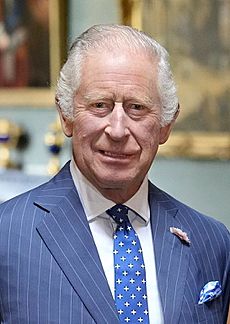
The monarch of the United Kingdom holds the main power. This power is carried out by the Commissioner for South Georgia and the South Sandwich Islands. The Commissioner is also the Governor of the Falkland Islands. The current Commissioner is Alison Blake, who started her role on July 1, 2022.
The government office is in Stanley, Falkland Islands. It includes a Chief Executive, three Directors, two managers, and a Business Support Officer.
The Financial Secretary and Attorney General for the territory are also appointed to similar roles in the Falkland Islands' government.
On the island itself, Government Officers manage visits by ships, fishing, and tourism. They represent the government "on the ground." A summer Deputy Postmaster runs the Post Office at Grytviken during the tourist season.
Since no one lives permanently on the islands, there is no legislative council and no elections. The UK Foreign, Commonwealth and Development Office (FCDO) handles the territory's foreign relations. Since 1982, the territory celebrates Liberation Day on April 25.
The territory's constitution was adopted on October 3, 1985. How its government is run was discussed in court cases between 2001 and 2005. The courts decided that the FCDO acts for the Crown of South Georgia and the South Sandwich Islands. This means its decisions cannot be challenged as if they were decisions of a UK government department. Therefore, the European Convention on Human Rights does not apply here.
Economy: How the Islands Make Money
Commercial sealing happened on the islands between 1817 and 1909. During that time, 20 visits by sealing ships were recorded.
Economic activity in South Georgia and the South Sandwich Islands is limited. The territory earns about £6.3 million each year. 80% of this money comes from selling fishing licenses (2020 figures). Other ways the territory earns money include selling postage stamps and coins, tourism, and fees for customs and harbors.
Fishing: A Key Industry
Fishing takes place around South Georgia and in nearby waters during certain months. The territory sells fishing licenses for Patagonian toothfish, cod icefish, and krill. These licenses bring in millions of pounds each year. Most of this money is used to protect fisheries and for research. All fishing is managed according to the rules of the Convention for the Conservation of Antarctic Marine Living Resources (CCAMLR).
In 2001, the South Georgia government was recognized by the Marine Stewardship Council. This was for its sustainable Patagonian toothfish fishery. It certified that South Georgia met the MSC's environmental standards. The certificate sets limits on when and how much Patagonian toothfish can be caught.
The Government of South Georgia and the South Sandwich Islands (GSGSSI) is in charge of fisheries and environmental protection. They have a contract with Workboat Services Limited (WBS) to operate the vessel MV Pharos SG. This ship patrols the South Georgia & South Sandwich Islands Maritime Zone. The current contract for this service runs until 2028.
Tourism: Visiting the Islands
Tourism has become a bigger source of income recently. Many cruise ships and sailing yachts visit the area. The only way to visit South Georgia is by sea, as there are no airports on the islands. The territory earns money from landing fees and selling souvenirs. Cruise ships often combine a visit to Grytviken with a trip to the Antarctic Peninsula.
Charter yacht visits usually start in the Falkland Islands. They last between four and six weeks. These trips allow guests to visit remote harbors of South Georgia and the South Sandwich Islands. Sailing vessels must now anchor offshore. They can no longer tie up to the old whaling piers. One exception is the recently improved yacht berth at Grytviken. All other docks at former whaling stations are within a 200-meter (656 feet) exclusion zone. Berthing or tying ropes ashore at these is not allowed. Yachts visiting South Georgia are usually expected to report to government officers at King Edward Point before sailing around the island.
Postage Stamps: A Collector's Item
A major source of income from abroad comes from selling South Georgia and the South Sandwich Islands postage stamps. These stamps are made in the UK.
The stamps are popular with topical stamp collectors. This is because only a few sets are issued each year, and they feature attractive subjects like whales.
There are only four real first day cover sets from March 16, 1982. They were stamped at the South Georgia Post Office. All others in circulation were stamped elsewhere. These four genuine sets were saved during the Falklands War by a British Antarctic Survey staff member. Everything else was burned, but these four sets were brought to the UK by Robert Headland.
Currency and Internet
The pound sterling is the official money of the islands. The same notes and coins used in the United Kingdom are used here.
The Internet country code top-level domain (ccTLD) for South Georgia and the South Sandwich Islands is .gs.
Ecology: Plants and Animals of the Islands

A Southern giant petrel on South Georgia Island.
|
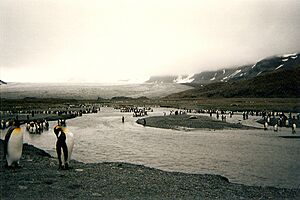
King penguins at St Andrews Bay, South Georgia Island, 1996.
|
Plants: Flora of South Georgia
Native Plants
The parts of the islands not covered by snow or ice are part of the Scotia Sea Islands tundra ecoregion. There are 26 known species of vascular plants native to South Georgia. These include six types of grass, four rushes, one sedge, six ferns, one clubmoss, and nine small forbs. There are also about 125 species of moss, 85 liverworts, and 150 lichens. About 50 species of large fungi also grow here. There are no trees or shrubs on the islands.
The largest plant is the tussock grass Poa flabellata. This grass mostly grows on raised beaches and steep slopes near the shore. It can reach up to 2 meters (6.6 feet) tall. Other grasses include the tufted fescue (Festuca contracta), the Alpine cat's-tail (Phleum alpinum), and Antarctic hair-grass (Deschampsia antarctica). One of the most common flowering plants is the greater burnet (Acaena magellanica).
Introduced Plants
Many plant species have been brought to the islands and now grow naturally. Many of these arrived with whalers in cattle fodder. Some are considered harmful to the native plants.
There have been 76 introduced plant species recorded in South Georgia. 35 of these have been removed, but 41 are still present. Plans are in place to remove 33 of these species by 2020. It is important to control these foreign species. They can easily enter this fragile ecosystem and take over resources like light and nutrients. This negatively affects the small, delicate habitats for South Georgia's animals.
Efforts to manage pest plants began in the early 2000s. They mainly focus on species that are easier to remove soon. These include bittercress and procumbent pearlwort. Other species will be targeted later. These programs involve the South Georgia and South Sandwich Islands Government, Royal Botanical Gardens Kew, and others.
Introduced plant species arrived mostly by accident with human activities. For example, annual meadow grass (Poa annua) is thought to have arrived around 1800 with the first sealers. It is now common across the island, especially at old sealing and whaling sites. Dandelions are believed to have been introduced with whaling operations. This happened when whalers brought soil from their home countries. Bittercress was first seen in 2002. It is thought to have arrived with building supplies at King Edward Cove. New introductions have slowed down recently due to strict biosecurity rules. Managing non-native species will take several years of regular work. This is to make sure all new plants from seeds in the soil are controlled before they grow fully.
Birds: Feathered Residents
South Georgia is home to many sea birds. These include albatross, a large colony of king penguins, Macaroni penguins, and other penguin species. There are also petrels, prions, shags, skuas, gulls, and terns. Birds found only on these islands are the South Georgia shag, South Georgia pipit, and the South Georgia pintail. Both South Georgia and the South Sandwich Islands are recognized as Important Bird Areas (IBAs) by BirdLife International.
Mammals: Seals, Whales, and Introduced Species
Seals are common on the islands, and whales can be seen in the surrounding waters. There are no native land mammals. However, reindeer, brown rats, and mice were brought to South Georgia by humans.
Rats arrived on the island as stowaways on ships in the late 1700s. They have caused a lot of harm to native wildlife. They have destroyed millions of eggs and chicks of ground-nesting birds. Before, the island's glaciers stopped rats from spreading. But now, these glaciers are slowly melting as the climate gets warmer. In 2011, scientists started a four-year plan to remove all rats and mice. This was the largest effort to get rid of rodents in the world at that time. The project was led by zoologist Anthony Martin. He said, "This is a problem caused by humans, and it's time that humans fixed past mistakes." In July 2013, they announced the success of the main part of the rat removal. 180 tonnes of rat poison were dropped over 70% of the island. This was the largest operation of its kind. Another 95 tonnes of poison were planned for January 2015. In June 2015, the program finished, and the island is believed to be rat-free. From 2017–18, a six-month search found no signs of rodents. Monitoring will continue for a few more years. In 2018, the number of South Georgia pipits clearly increased.
Reindeer were brought to South Georgia in 1911 by Norwegian whalers. They were used for meat and for sport hunting. In February 2011, authorities announced that all reindeer would be removed. This was because they were harming native species and might spread to untouched areas.
Marine Ecosystem: Life in the Ocean
The seas around South Georgia have a high level of biodiversity. A recent study (2009–2011) found that South Georgia has one of the highest levels of biodiversity among all ecosystems on Earth. In terms of species, marine life found only in this ecosystem is more diverse than in well-known places like the Galápagos or Ecuador. The marine ecosystem is thought to be vulnerable. This is because its cold temperatures mean it recovers very slowly. To protect marine biodiversity, the territory's government created the South Georgia and the South Sandwich Islands Marine Protected Area on February 23, 2012. This area covers 1.07 million square kilometers (413,000 square miles).
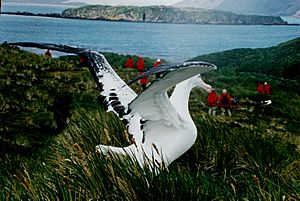
A Wandering albatross at South Georgia Island.
|
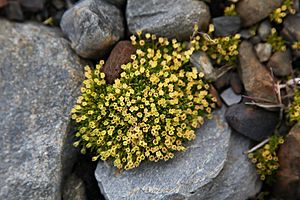
Antarctic Pearlwort at St. Andrews Bay, South Georgia.
|
Military Presence
After the Falklands War in 1982, the British military kept a full-time presence at King Edward Point on South Georgia. This presence was reduced in the 1990s. The last military group left South Georgia in March 2001. This happened after a new station was built for the British Antarctic Survey.
The main British military base in the region is at RAF Mount Pleasant. This is next to the Mare Harbour naval base on East Falkland. There are also three radar stations on the Falklands: RRH Mount Kent, RRH Byron Heights, and RRH Mount Alice. A few British naval ships patrol the area. They visit South Georgia a few times each year. Sometimes, small groups of soldiers are deployed. Flights by RAF Airbus A400M and Airbus A330 MRTT aircraft also sometimes patrol the territory.
A Royal Navy warship carries out the Atlantic Patrol Tasking South mission in the surrounding area.
HMS Endurance, the Royal Navy ice-patrol ship, worked in the South Georgia area during parts of most southern summer seasons. This continued until it was almost lost due to flooding in 2008. The ship did mapping work and helped with scientific fieldwork for the British Antarctic Survey. It also assisted film crews and youth expedition groups. While waiting for a decision on Endurance's future, the Royal Navy rented a Norwegian icebreaker. This ship was renamed HMS Protector and served as a replacement for three years. In September 2013, the British Ministry of Defence bought the ship. On October 7, 2013, it was announced that Endurance would be sold for scrap.
See also
 In Spanish: Islas Georgias del Sur y Sandwich del Sur para niños
In Spanish: Islas Georgias del Sur y Sandwich del Sur para niños
- Cape Flannery
- Hardy Point
- Herd Point
- Horsburgh Point
- Hueca Point
- Index of South Georgia and the South Sandwich Islands-related articles
- List of Antarctic and subantarctic islands
- Lists of islands




